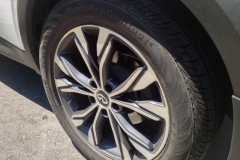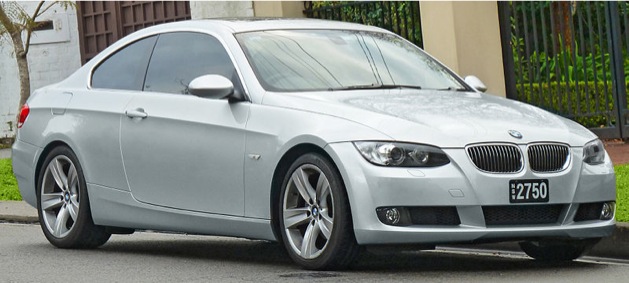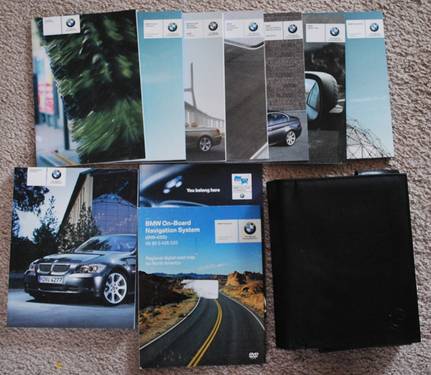





Source:
http://www.e90post.com/forums/showthread.php?t=468750
Is it German engineering gone wrong, or user error?
E90, E91, E92, and E93 are BMW’s designations for the 2006-2012 3-series sedan, wagon, coupe, and convertible. You’ve seen them around, reasonably affordable entry-executive cars driven by up and coming young professionals blasting dubstep and weaving through traffic under the influence of 10 shots of Jager.

I kid, of course. I’ve owned a couple BMWs myself and adored them. I’m actually quite fond of the brand including the current E9x and most of its predecessors, but I’m not so keen on the pointless X6, the finicky 7-series, the hideously ugly 5-series GT, or any of BMW’s other directionless wanderings.
A baffling engineering choice on the E9x (and several other models) turns the simple task of battery replacement into an expensive ordeal requiring a dealer visit. To replace a battery, an OEM-matching unit (correct amperage, lead acid/wet vs AGM, etc) must be installed at a cost of up to $500 including labor. Additionally, the dealer or shop has to use a BMW-specific diagnostic tool to inform the vehicle of the type and condition of the battery installed.
Failing to do so could result in battery leakage or explosion.
Did you read that? Allow me to repeat it.
Failing to do so could result in battery leakage or explosion.
Nuts, right? Having owned a wide variety of luxury cars from around much of the world, I understand and accept high maintenance costs. Precision engineering occasionally comes with the burden of more expensive fluids, higher quality parts, more specific service intervals, and more care on the part of the owner.
Believe me, I get it. You can’t buy a high-end vehicle, neglect it like a Toyota pickup truck, and expect the mess of hardware and software to function properly. To enjoy greater performance and luxury, the machine requires a bit of pampering.
None of this battery registering and programming nonsense, however, is at all necessary, and the end result is money out of the pocket of the owner and compromised safety and dependability.
No longer, in modern BMWs, is the voltage regulator in “charge,” (pun intended) of regulating the generator and current. By putting this control in the hands of the computer, the car can in theory determine the charging level needed for the age and condition of the battery while also factoring in operating and ambient temperatures. The alternator’s charging level can be cycled with software, resulting in a fuel savings of possibly a tenth of a mile per gallon. It will also allow a new battery, under the stresses of BMW’s modern equipment and luxury accessories, to enjoy a normal service life and offer more reliable starting in cold weather.
Now consider, based on 15,000 miles of annual driving, how much fuel would be saved in a year.
Say your BMW 335i averaged 21mpg in mixed driving with premium fuel at a cost of $3.30/gallon. At 15,000 miles, your total annual fuel cost would be $2357.14.
By increasing that average fuel economy by a tenth to 21.1 mpg, you will spend $2345.97 per year on fuel. This is a total savings of $11.17. That’s right, ELEVEN DOLLARS SAVED PER YEAR. If you want to be generous, assume the car is good for thirty years, fuel prices remain stable, and you choose to own it for 450,000 miles. That’s a savings of $335.10 over three decades.
$335 saved sounds like a nice deal… for the extremely rare person who drives the same car for half a million miles and three decades. Most cars are wrecked or scrapped before reaching 200,000 mi.
Now consider the cost of the battery every five years. A battery in a luxury car can cost anywhere from $100-$250. Being generous, assume that without BMW’s “clever” engineering, a battery would cost $250 every five years. That’s six batteries over thirty years of driving which amounts to an added expense of $1500 over the life of the car.
This doesn’t include cost and inconvenience of having to tow your car to the dealer. AAA can’t pull up to your doorstep with a battery and pop it in since they lack the tools to program the vehicle’s computer, nor can you do it yourself, so unless you pony up for an unlimited towing plan, expect to pay a per-mile price to get your car to a qualified BMW mechanic.
The most important question, since you’re reading this particular blog, is how does this technology contribute to motoring enjoyment? How does it enhance one’s affection for, pleasure of, and desire to continue owning such a car?
In three words: it does not.
BMW technicians and fanatics insist that if you had read through the owners manuals, you would have known about the requirement to have the battery programmed, therefore making it YOUR fault for enduring a battery that leaks or explodes.

This is the pile of documentation that comes with new BMWs. Am I supposed to read all of it before getting on with the act of motoring? Is this really mandatory? Would it still be necessary if BMW reigned in its engineers and exercised some practical discipline?
Specific octane requirements are understandable. Specific motor and gear oil viscosities are understandable. But for at least half a century of motoring, batteries have been batteries, so the expectation of owners is that, like gasoline, most batteries will suffice as long as they have sufficient cranking amps and come in a compatible shape and size. It would seem wise then for BMW to place a gigantic warning label, printed in an obnoxious primary color, right next to where the battery is installed, especially if this has the potential to cause injury or fire.
Or, since the car is so gosh darned “smart,” it could perhaps play a warning chime and put an error message IN ALL CAPITAL LETTERS on the gauge cluster that says “HEY! I SEE YOU’VE INSTALLED A BATTERY OR MESSED WITH THE ELECTRICAL SYSTEM. VISIT YOUR DEALER TO PROGRAM THE BATTERY OR ELSE IT MAY EXPLODE.”
BMW isn’t the only luxury brand guilty of unnecessarily complicating automobiles. Some late model Audis require battery registration, and Mercedes-Benz has for the past decade been using two batteries in its increasingly complicated high-end sedans. The question of whether this is necessary is entirely valid, especially if Lexus, Infiniti, and others manage to get by with more traditional charging systems in vehicles with equally high levels of standard equipment.
So, what about the generally valid defense that expensive cars will require expensive service?
Are we to conclude that a BMW 328i, which starts at $34,000, is an expensive car in 2011? Really? Should I be expected to pay double for something as simple as a battery on a car that costs about the same as a Buick Enclave or Toyota Avalon? Really?
The 3-series is an entry-executive car, and among its owners are entry-executive level incomes. In Britain, the 3-series has outsold the Ford Mondeo, a standard front-drive family car. This isn’t a Mercedes S-class, E-class, Rolls Royce, or even a BMW 5- or 7-series. It’s higher-end transportation for the aspirational middle class. It’s sporty, its beautiful, and its even a bit luxurious, but it’s a far cry from “high end” if we look at the luxury car market in its entirety.
A point for BMW to consider is that when these E9x 3-series BMWs become decade-old used cars, they will appear as trade-ins at Chevy dealers or as auction purchases at “Bob and Dan’s Luxury Imports Behind The Concrete Factory.” None of those dealers will be aware of how delicate the charging system is, and the cars will, as a result, develop reputations for being less dependable than they actually are. Word of mouth spreads quickly, which is why many older BMWs and most Lexuses have high resale values — servicing is simple and long term ownership is a generally flawless experience. Likewise, the opposite could happen to the E9x, earning a reputation as a complicated, fussy car.
Now, in reference to the thread that was linked at the top of this article, the battery itself, fortunately, did not explode. A pyrotechnic safety mechanism caused the terminal connector to explode as designed and disabled the electrical system, protecting the battery itself from catastrophic, acid-spewing failure. Unfortunately, this left the vehicle stranded on a 50mph road with little room to pull over. So, if the fire risk was mitigated, what about the more frightening possibility of being plowed over by a semi truck full of propane?
This is not joyful motoring. This is Germany getting even for losing the war.
Leave a Reply